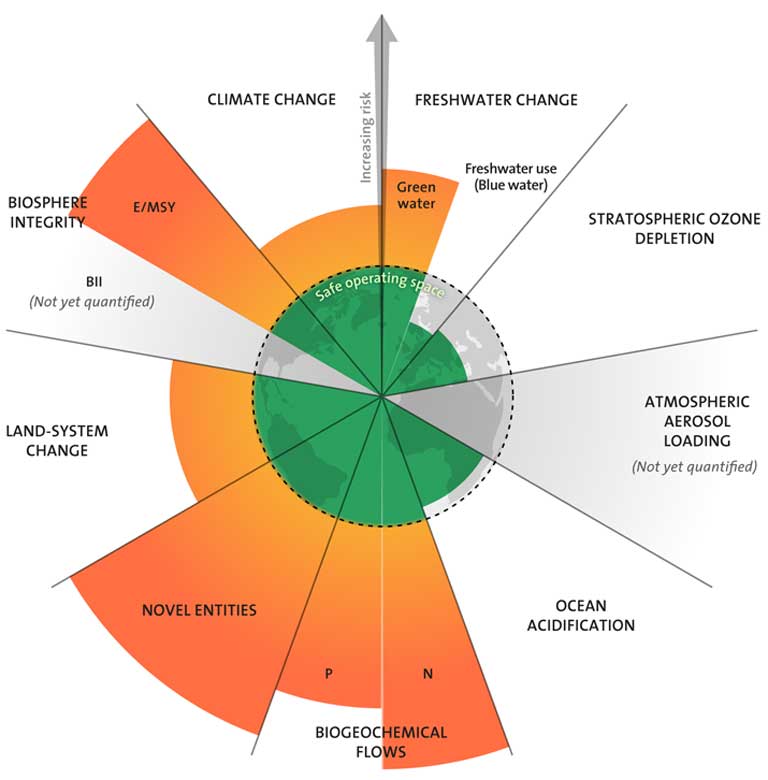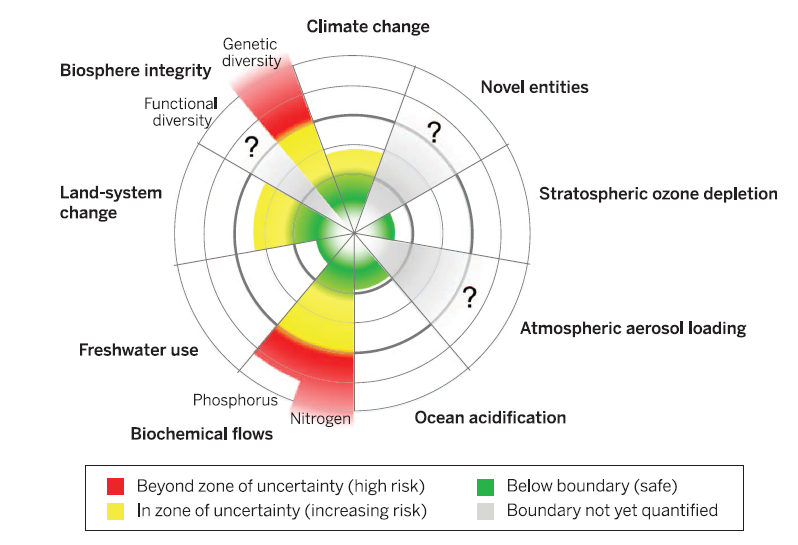Planetary Boundary¶
- According to experts, we have passed the planetary boundary for land systems change — the human-caused loss of forest — and risk destabilizing Earth’s operating systems [27].
- Scientists calculate we must retain 85% of tropical and boreal forests, and 50% of temperate forests, to stay within Earth’s “safe operating” bounds, but the number of trees worldwide has fallen by nearly 50% since the dawn of agriculture [27].
- From 2001 to 2021, forest area roughly half the size of China was lost or destroyed across the planet; in 2021, tropical forests disappeared at a rate of about 10 football fields per minute [27].
- Despite these losses, solutions abound: Some of the actions that could bring us back into the safe operating space are securing Indigenous land rights, reforestation and landscape restoration, establishing new protected areas, redesigning food systems, and using finance as a tool [27].
The green zone is the safe operating space, the yellow represents the zone of uncertainty (increasing risk), and the red is a high-risk zone.The planetary boundary itself lies at the intersection of the green and yellow zones. The control variables have been normalized for the zone of uncertainty; the center of the figure therefore does not represent values of 0 for the control variables.The control variable shown for climate change is atmospheric CO2 concentration. Processes for which global-level boundaries cannot yet be quantified are represented by gray wedges; these are atmospheric aerosol loading, novel entities, and the functional role of biosphere integrity [27].
Three of the PBs (climate change, stratospheric ozone depletion, and ocean acidification) remain essentially unchanged from the earlier analysis.
A planetary boundary framework critique¶
The planetary boundary framework, while providing a useful model for measuring change, is not fully accepted by all scientists. Some note that because the nine boundaries are all so deeply interconnected, it can be challenging to separate them out and evaluate each individually in a meaningful way. This is especially true for land system change, which underpins and influences nearly every other boundary [27]. Another criticism is that the land system boundary focuses on forests exclusively, and not on any other ecosystem type [27].
Land system solutions:¶
Securing Indigenous land rights [27]¶
An estimated 36% of ecologically intact forests and 80% of planetary biodiversity lie within Indigenous peoples’ territories. Empower them, and they could guide forest conservation. A study by political scientists published in 2020 concluded that Indigenous peoples were the best stewards of the Amazon Rainforest, but only when their property rights were safeguarded by government enforcement. Others found that large, legally protected territories are necessary for Indigenous peoples in Brazil to maintain their culture as well as local biodiversity.
Reforestation and landscape restoration [27]¶
Establishing new protected areas [27]¶
Redesigning food systems [27]¶
Follow the money [27]¶
Investments and government subsidies now often fuel deforestation, but could just as easily support conservation. In fact, pressure is mounting today for companies that produce and sell major agricultural commodities to address deforestation within their operations and supply chains. Tools such as TRASE now provide supply chain mapping, but they don’t yet have the capacity to monitor at the detailed scales needed to change industries and halt deforestation [27].

